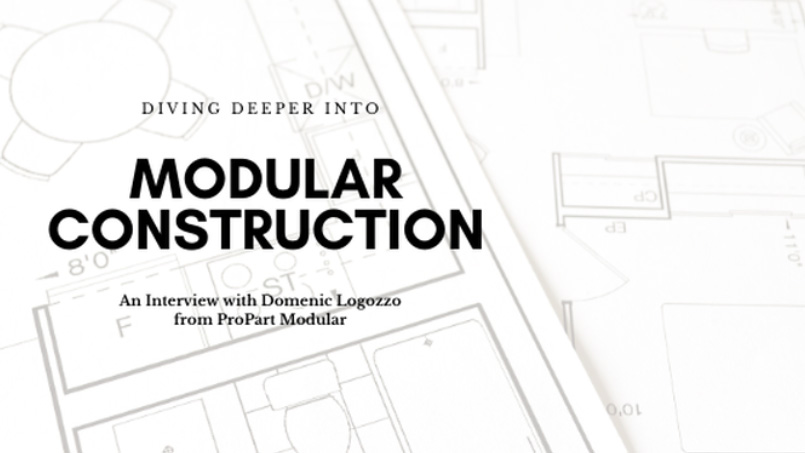News
ProPart Modular > News > News > Diving Deeper into Modular Construction – An Interview with Domenic Logozzo from ProPart
Diving Deeper into Modular Construction – An Interview with Domenic Logozzo from ProPart
The modular construction “trend” seems to be a popular headline when it comes to construction news. But is it really a trend if the method of construction has been around since as early as the mid-19th century?
In 1908, Richard Sears began selling his first modular product by catalog. What soon followed, was the sale of over 500,000 units by Sears Roebuck Co. Following the second world war, the demand increased significantly and the purposes and benefits of modular construction then are vastly comparable to the benefits we see today.
It was in the 1940’s that the industry expanded to commercial and the demand has been growing since. With a recognized skilled labor shortage in the country and a widely documented lack of productivity in the conventional construction industry, the need for a cost and time efficient means of construction is most definitely there.
We caught up with Domenic Logozzo of the ProPart Modular team to discuss the growth of modular, the comparisons we can draw from this method of construction and who can stand to benefit from going modular the most.
You have a lot of knowledge in the construction industry, with your family being heavily involved in construction. How long have you been with ProPart Modular?
My father and brother have both been in conventional construction for 50 and 25 years, respectively. I’ve been with ProPart Modular for about 17 years.
So, there is no doubt that you know the ins and outs of modular construction. What roles have you worked in within the company?
I’ve worked in operations, purchasing, project management, scheduling, sales and general management.
In the time you’ve worked at ProPart, has the modular industry grown at a steady rate or did you notice a rapid growth?
Over the last 5-10 years I’ve seen more of a steady growth in the industry. Companies are pushing to be better and more efficient and the modular construction industry caters to that. It’s a cleaner, faster and more flexible method of building.
How much easier is the modular building process in comparison to conventional construction?
Aside from the speed, a huge benefit is that we build in a climate-controlled space; the project is completed away from the elements. We are in complete control of our modular structures and the weather doesn’t affect scheduling. Assembly is quick and the flexibility and ease of making design changes are some of the main advantages of modular vs conventional.
In your experience, can you confidently say that there are less delays in the process?
There are less delays since there are less steps involved than there are in conventional construction. We manufacture our own panels and wall system; we control our own schedule and availability.
What range of companies/ businesses have you worked with?
I’ve worked with a wide range of businesses. From small retail vape shops to large aerospace companies. The modular business is not limited to certain types of industries. Whether it’s an outdoor application, office environment, climate-controlled environment or an in-plant manufacturing application, the spectrum is wide. The sky’s the limit!
Having worked in so many markets, what sets ProPart Modular apart from other modular construction companies?
We’ve always had a strong tie in with customer relations. We’re just as involved after the project is done as we are during the initial stages. We view ourselves as an extension of the companies we work with vs just another supplier. Over 70% of our customer base are returning customers which, in my opinion, is largely in part to our attentiveness to customer care.
In your opinion, are there any specific industries that could benefit from going modular?
I would have to say companies in need of controlled environments. Primarily the healthcare and pharma industries could stand to benefit the most from clean rooms/ controlled environments. We can also utilize wasted square footage in buildings or warehouses to produce more efficient work space and offices. We have custom, flexible solutions for anyone.
What is the average time span for builds?
It varies on the size of the project but on average, 3-5 weeks.
For example, Six Nations of Grand River needed a security divider wall after a security breach. The whole process from start to finish took one week.
There is no doubt that modular beats conventional in terms of speed, are people often hesitant about the quality due to fast completion rate?
I would say no. A misconception about modular may be that the structures aren’t as strong, but that is far from the truth.
There are less steps and processes involved, which is why we are so much faster. Most panels are pre-finished, and everything is very plug and play. We don’t need to use big tools or fasteners for anything and there is far less mess compared to conventional building with drywall.
We meet all OBC requirements and must meet the same standards and codes as conventional building.
Is there anything else you’d like to add that we may not know about ProPart?
Many years ago, our founder Todd Frankland, shared a thought and a belief that I believe still holds true today:
“ProPart has always stood by our belief that change occurs so frequently that permanent walls really become just a temporary solution. In today’s environment, few companies can afford the tear down, business interruption and reconstruction expense of conventional construction. Successful companies today are ready to respond, and their wall systems should be just as adaptable to change.”
